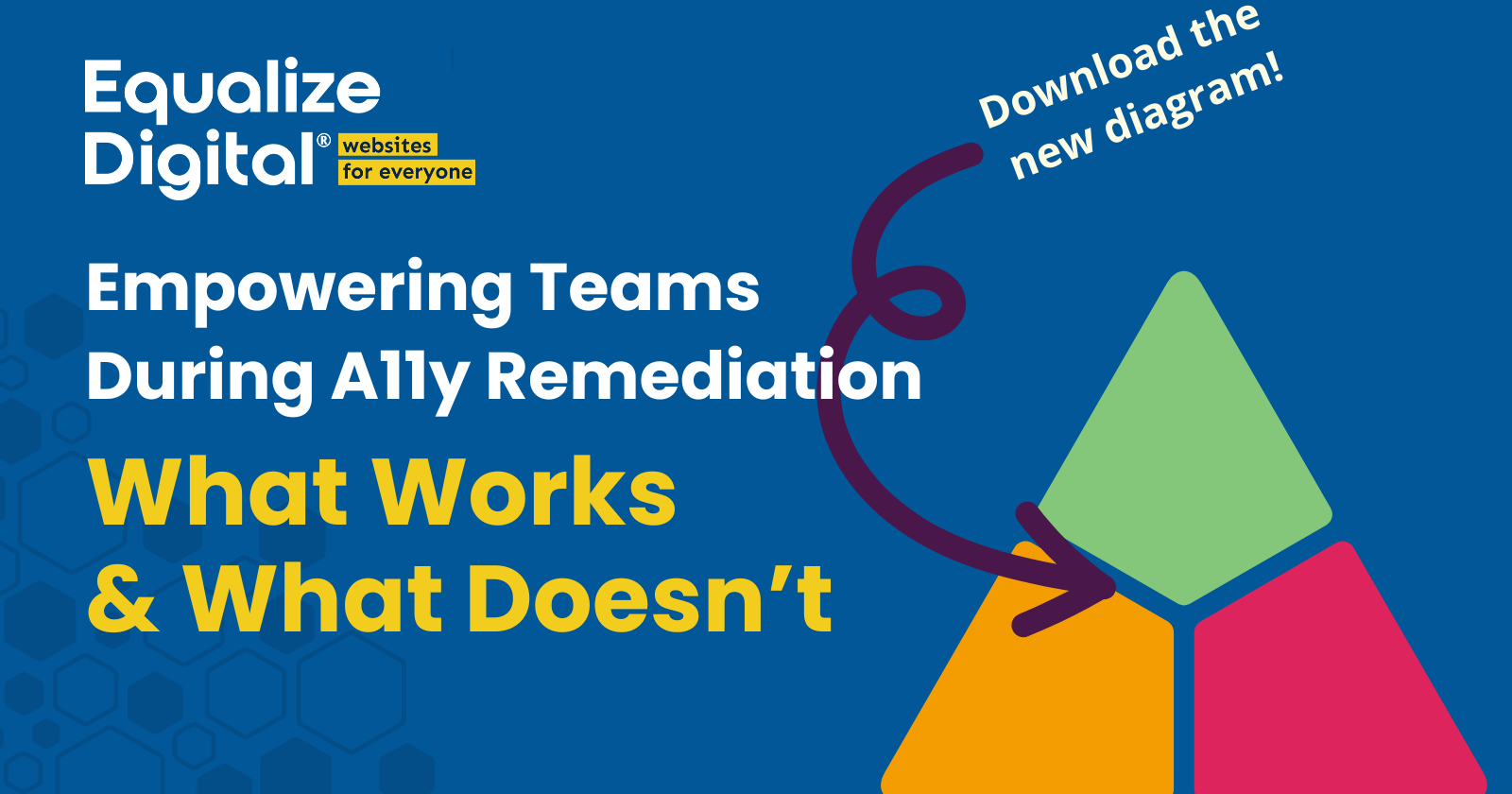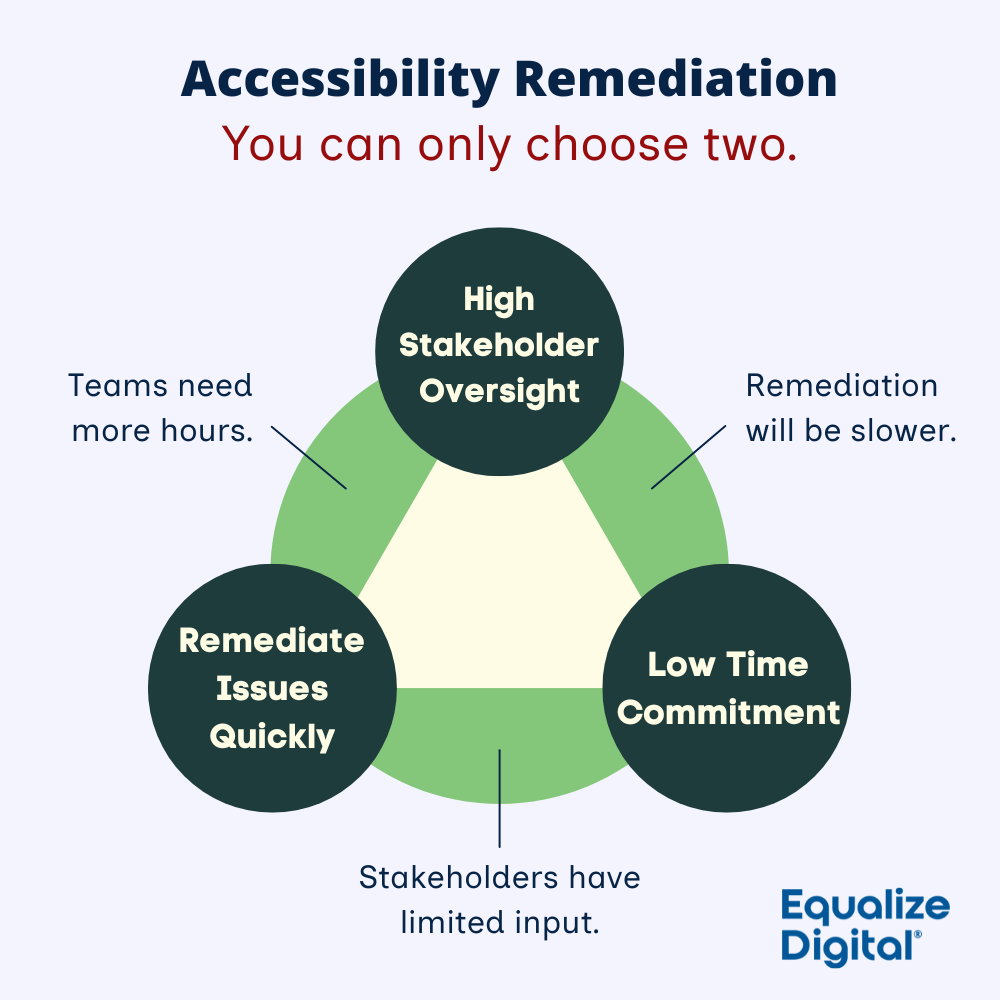
Navigating the complexities of accessibility remediation can be intimidating for organizations, especially with the risk of backslides and common pitfalls along the way. Whether it’s addressing third-party vendor challenges, balancing competing priorities, or ensuring alignment across teams, achieving sustainable accessibility requires thoughtful strategies and continuous effort.
In this post, we’ll explore practical guidance, real-world examples, and share insights to help organizations tackle accessibility remediation effectively without losing sight of their long-term goals.
Understanding Accessibility Remediation
At its most basic, accessibility remediation is the process of fixing known accessibility problems on an existing website or application. These can range from the very simple, like remembering to add alternative text to non-decorative images, to the painstakingly complex, like fixing code in a large “mega” menu so that it can be used with assistive technology. And for the uninitiated, one of the more important things to know is that accessibility remediation is part of a dynamic duo.
Much like peanut butter and jelly, macaroni and cheese, or chips and salsa, accessibility remediation is always paired with some form of accessibility audit (sorry, not sorry on the food analogies). You have to know what the problems are in order to fix them. Often, when trying to identify accessibility issues, organizations will use a combination of automated and manual evaluation methods, measuring against the Web Content Accessibility Guidelines (WCAG).
There are accessibility considerations for code, design, content, and how users move through a site or application. The underlying objectives of an accessibility remediation project can also vary significantly, from basic priorities like legal compliance or risk management, to more forward-thinking efforts like creating the best user experience possible to maximize conversions and revenue.
Due to the sheer scope of accessibility standards and the myriad priorities your organization may have related to accessibility, it’s not hard to imagine that any genuine accessibility effort will involve a lot of people on your team.
Or, at least it should.
Common Accessibility Remediation Blockers
When an organization undertakes its first accessibility remediation project, there will always be early setbacks. These usually involve underestimating the time and effort required to do this work, a lack of in-house expertise in a relatively specialized subject, and redefining roles and responsibilities for managing accessibility.
These are initial growing pains that virtually every organization will experience when it decides to get serious about accessibility.
The remediation blockers we’re covering below are the ones you really need to look out for. At best, they will introduce massive inefficiencies into the remediation process, slowing progress until they’re rooted out. And at worst, they will keep you locked in place, never achieving meaningful progress.
Lack of Buy-In Across Teams and Departments
When organizations focus only on sporadic fixes without embedding accessibility into their overarching digital strategy, they risk recurring compliance failures and usability issues. This piecemeal approach often leads to accessibility backslides during site updates or redesigns, as teams lack alignment and awareness around accessibility principles. The top symptom of this blocker is that efforts around accessibility are consistently reactive, inefficient, and costly.
Ineffective Communication
Communication or process gaps during hand-off between leadership, designers, developers, and content creators can create misaligned priorities, resulting in large numbers of preventable accessibility issues. Without consistent collaboration and shared accountability, accessibility efforts become fragmented or even isolated to a single stage of a project, greatly reducing efficiency. The top symptom of this blocker is that accessibility is only considered at one or two touchpoints, typically very late in project cycles or sprints.
Insufficient Training and Awareness
Without continuous education, teams will gradually become less proficient at ensuring their day-to-day tasks produce accessible outcomes. This often leads to recurring issues, such as developers misusing ARIA, designers failing to check color contrast, and content teams forgetting to put alternative text on images. All of this and more will ultimately undermine remediation efforts and require teams to go back and redo parts of their work later. The top symptom of this blocker is that when asked, team members struggle to remember the last time they had an accessibility training.
Over-Reliance on Inaccessible Third-Party Tools
Relying on third-party tools that introduce accessibility issues can jeopardize both usability and compliance. When teams prioritize convenience over accessibility—like an accounting team favoring point-of-purchase software that meets their functional needs but excludes disabled users — they may be locking themselves into a long list of unfixable accessibility issues, because they can’t fix what they can’t control directly. The top symptom of this blocker is an accessibility evaluation coming back with most issues pointing to a handful of embedded or integrated solutions from third-party vendors. (e.g. videos, cookie banners, chat widgets, payment processors, etc.)
Superfluous Red Tape or Bureaucracy
Imposing excessive layers of approval and bureaucracy slows remediation efforts to a crawl, leaving teams unable to keep up with the pace of new content and features being added. When every minor change requires stakeholder review, accessibility fixes are delayed, and new issues are introduced faster than they can be resolved. Empowering remediation teams to act quickly is crucial to avoid this bottleneck. The top symptom of this blocker is a steady increase in the number of accessibility issues present, despite the existence of adequate capacity to correct issues within each team or department.
Avoid the “Quick Fix” Trap
In March 2025 alone, there were 457 lawsuits filed in the USA against organizations with inaccessible websites. And over the years, quite a few organizations that received threatening letters or had lawsuits filed against them have reached out to us for help.
They all wanted the same thing: Accessibility problems gone. And fast.
In early sales conversations, my response is always the same.
Accessibility is a journey, not a destination.
I’m sure it has cost us a few projects, where a (less honest) competitor promised a one-and-done fix. But, I don’t want to lie to people. And they will find out the truth within a few months, when their site ends up right back where it started: Riddled with accessibility issues, because they treated the symptom and not the disease.
Without fixing the underlying causes of how accessibility errors are getting introduced in the first place, achieving long-term conformance with any accessibility standard is not possible. This is why we guide customers through a specific process that includes not only auditing and remediation but also strategic planning, training, and ongoing monitoring.
We do this specifically to help them avoid the “Quick Fix” Trap. Because otherwise, the customer will stay locked in a cycle of paying inflated costs for bulky auditing and remediation projects every year or two, forever. And as much as one-and-done accessibility vendors (who stand to gain from having customers locked in this cycle) would claim otherwise, there is a better way forward.
You’re Only as Accessible as Your Least Accessible Vendor
An organization’s website is only as accessible as its least accessible vendor because third-party tools and integrations often serve as critical components of a website’s functionality.
Features like payment gateways, video players, booking systems, or chat widgets frequently rely on external providers. When these tools fail to meet accessibility standards, they can create significant barriers for users with disabilities—even if the rest of the website is perfectly compliant.
Vendors that neglect accessibility not only compromise the usability of a website but also expose the organization to legal and reputational risks. Courts and users alike may hold the company responsible for barriers introduced by third-party tools, because it can be very hard to tell what is first-party and what is third-party code. This means that even a single inaccessible integration with an external vendor can put an otherwise compliant organization at risk of litigation or customer backlash.
Proactively evaluating vendor solutions for accessibility can ensure a cohesive and inclusive digital experience. Organizations should consider accessibility as a key criterion when selecting or renewing contracts with third-party providers. Before purchase, ask to see any official documentation each vendor has around the accessibility of their solution (commonly, a VPAT / ACR). And if an audit is identifying a substantial number of issues in third-party systems, work with those vendors to identify and address accessibility gaps—or even requiring compliance as part of contractual agreements.
Having documented proof that your procurement policies factor in accessibility, that you notify vendors about known accessibility issues, and that you will discontinue contracts with inaccessible vendors if they fail to address issues, gives you a solid footing to prove as an organization that you’re doing your due diligence.
Article continued below.
Stay on top of web accessibility news and best practices.
Join our email list to get notified of changes to website accessibility laws, WordPress accessibility resources, and accessibility webinar invitations in your inbox.
Accessibility Remediation Do’s and Don’ts for Empowering Teams
There is a lot to unpack in this post. As someone who does well with lists, I’m going to give you a TL;DR (too long, didn’t read) version designed to get to the central truths I want to convey, based on years of selling, observing, and helping to manage accessibility projects for organizations of all sizes.
Make Everyone Own Their Parts
✅ Do establish clear ownership and collaboration across teams.
❌ Don’t isolate accessibility remediation responsibility to one person or small group.
Prioritize Long-Term Thinking
✅ Do invest in continuous training, at least annually to keep everyone up to date.
❌ Don’t treat accessibility as a one-off project.
Integrate Accessibility in Processes
✅ Do integrate accessibility into every process, from design, to development, to QA.
❌ Don’t frantically rush out temporary patches and band-aids every year or two.
Accessibility Remediation “Pick Two” Triangle
Accessibility remediation often involves navigating complex trade-offs between key priorities, and organizations face the challenge of balancing stakeholder oversight, time commitments, and speed of implementation. These three factors are interconnected, but no workflow can fully optimize all of them simultaneously.

High Oversight, Low Time
This combination prioritizes thorough stakeholder engagement while minimizing the time investment for each participant. Such an approach ensures that decision-making reflects a wide range of perspectives, including leadership, compliance experts, and developers. However, the trade-off is that remediation processes may become slower and less responsive due to the need to navigate approval cycles and consult multiple stakeholders.
Low Time, Remediate Quickly
This pairing emphasizes agility and efficiency by minimizing stakeholder involvement and focusing on fast-paced remediation efforts. With fewer layers of oversight, teams can implement changes swiftly to address urgent accessibility barriers, ensuring users experience immediate improvements. While this approach is practical for moving fast, organizations must remain vigilant to ensure accessibility improvements are sustainable and compatible with broader strategic goals.
Remediate Quickly, High Oversight
Balancing stakeholder oversight with rapid remediation results in a highly responsive workflow that maintains accountability while tackling pressing accessibility issues. However, the trade-off is a higher time commitment, as teams must engage in frequent meetings, reviews, and iterative feedback loops to align priorities with quick fixes. Organizations adopting this approach need to carefully manage stakeholder expectations and streamline communication to avoid creating overwhelm.
Let Us Help Find Your Remediation Sweet Spot
Finding the right balance for accessibility remediation can be challenging, but it’s essential to ensure progress without compromising your organization’s goals. Let’s work together to identify the best approach, streamline your workflows, and make sustainable accessibility a reality. Contact us for an initial consultation.